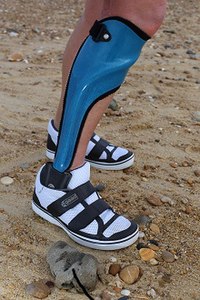
Photo from wikipedia
Side-step cutting is a common evasive maneuver which is typically performed without prior anticipation. Studies quantifying joint work and its inter-joint proportions in cutting have not accounted for work done… Click to show full abstract
Side-step cutting is a common evasive maneuver which is typically performed without prior anticipation. Studies quantifying joint work and its inter-joint proportions in cutting have not accounted for work done by the foot, even though this segment has been shown to be an important source of mechanical work in walking, running, and landing. The aims of this study were to: (1) quantify the magnitude of foot work performed and provide a more precise account of percentage joint work during cutting, and (2) examine the effect, a lack of anticipation had on these variables. Three-dimensional motion capture with forceplates were used to assess the cutting behaviour of 17 healthy participants. All participants performed a 45° cut with an approach speed of 4 m/s. Hip, knee, and ankle joint work were calculated using inverse dynamics; whilst foot work was quantified using the Unified-Deformable foot method. The foot contributed up to 12.45% and 3.09% of total limb negative and positive work, respectively. Unanticipated cutting significantly reduced ankle positive work (-0.09 J/kg [95% CI -0.13 to -0.06], P < 0.001) and significantly reduced percentage ankle positive work (-2.17% [95% CI -3.47 to -0.86], P = 0.001). The foot performs as much negative work as the hip but had only a minor contribution to positive work during cutting. Anticipation had a negligible influence on joint work and its inter-joint proportions. The foot should not be neglected in understanding whole-body dynamics during cutting, with greater understanding of its function potentially useful for informing athletic footwear design and cutting technique modification.
Journal Title: Journal of biomechanics
Year Published: 2020
Link to full text (if available)
Share on Social Media: Sign Up to like & get
recommendations!